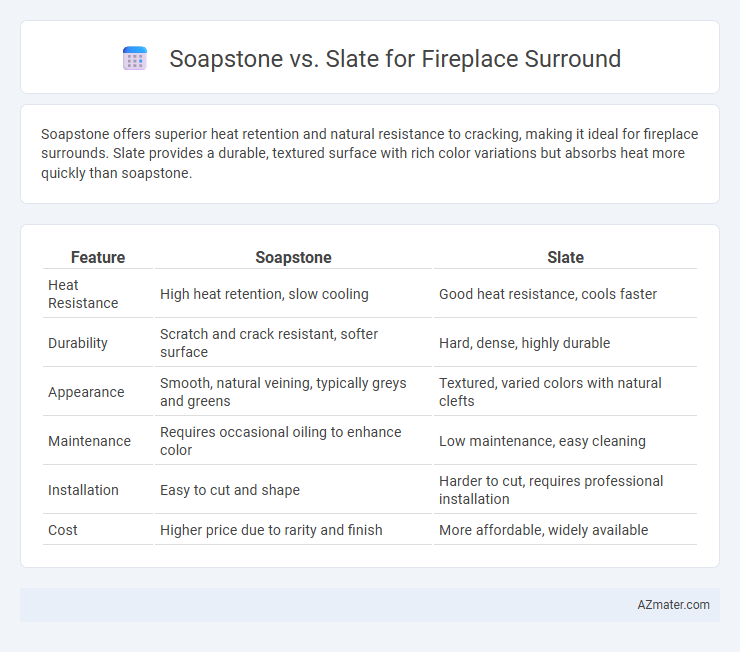Soapstone offers superior heat retention and natural resistance to cracking, making it ideal for fireplace surrounds. Slate provides a durable, textured surface with rich color variations but absorbs heat more quickly than soapstone.
Table of Comparison
| Feature | Soapstone | Slate |
|---|---|---|
| Heat Resistance | High heat retention, slow cooling | Good heat resistance, cools faster |
| Durability | Scratch and crack resistant, softer surface | Hard, dense, highly durable |
| Appearance | Smooth, natural veining, typically greys and greens | Textured, varied colors with natural clefts |
| Maintenance | Requires occasional oiling to enhance color | Low maintenance, easy cleaning |
| Installation | Easy to cut and shape | Harder to cut, requires professional installation |
| Cost | Higher price due to rarity and finish | More affordable, widely available |
Introduction: Comparing Soapstone and Slate for Fireplace Surrounds
Soapstone and slate are popular natural stones for fireplace surrounds, offering distinct aesthetic and functional benefits. Soapstone provides superior heat retention and a smooth, warm surface, while slate offers a textured, durable finish with a variety of color options. Choosing between soapstone and slate depends on desired heat performance, design preference, and maintenance requirements.
Aesthetic Appeal: Soapstone vs Slate
Soapstone offers a smooth, warm surface with subtle veining that provides a timeless, natural elegance to fireplace surrounds, complementing both traditional and modern decor. Slate features a more textured, layered appearance with rich, earthy tones that add rustic charm and visual depth, suitable for cozy, contemporary, or farmhouse styles. Both stones offer unique aesthetic qualities, with soapstone delivering soft sophistication and slate providing bold, natural character.
Durability and Longevity Comparison
Soapstone offers exceptional durability and heat resistance, making it highly suitable for fireplace surrounds with its ability to withstand high temperatures without cracking or warping. Slate provides good durability but is more brittle and prone to chipping or breaking under heavy impact or thermal stress compared to soapstone. Over time, soapstone's non-porous nature ensures minimal wear and staining, resulting in longer-lasting performance in fireplace applications versus the more porous and less resilient slate.
Heat Resistance and Retention Properties
Soapstone exhibits superior heat resistance and exceptional heat retention properties, making it ideal for fireplace surrounds as it absorbs and radiates warmth evenly over time. Slate, while also heat resistant, cools down more quickly, providing less consistent heat distribution. Choosing soapstone enhances thermal efficiency and comfort, ensuring the fireplace remains warm long after the fire has died down.
Maintenance Requirements for Each Material
Soapstone requires minimal maintenance for fireplace surrounds, as its dense, non-porous surface resists stains and can be easily cleaned with mild soap and water. Slate, while durable, may need periodic sealing to protect against moisture and staining, and chips or cracks can require more careful repairs. Both materials handle heat well, but soapstone's non-porous nature makes it more resistant to soot and easier to maintain over time compared to slate.
Cost Differences: Soapstone vs Slate
Soapstone generally costs more than slate for fireplace surrounds, with prices ranging from $50 to $100 per square foot compared to slate's $30 to $60 per square foot. Installation expenses for soapstone can also be higher due to its density and weight, requiring specialized tools and expertise. Slate offers a more budget-friendly option without compromising durability or aesthetic appeal, making it a popular choice for cost-conscious homeowners.
Installation Process and Considerations
Soapstone offers easier installation for fireplace surrounds due to its softer, more workable nature, allowing for precise custom fitting and shaping with basic tools. Slate, being harder and more brittle, requires professional handling and specialized cutting equipment to prevent cracking during installation. Both materials demand careful sealing to enhance durability and resist heat and moisture exposure in the fireplace environment.
Environmental Impact and Sustainability
Soapstone fireplace surrounds offer a lower environmental impact due to their natural heat retention properties, which enhance energy efficiency by reducing heating needs. Slate, while durable and abundant, often requires more intensive quarrying and processing, leading to higher carbon emissions compared to soapstone. Choosing soapstone supports sustainability with its minimal processing and exceptional longevity, making it a more eco-friendly option for fireplace surrounds.
Popular Design Styles and Color Choices
Soapstone offers a smooth, warm surface in shades of gray, green, or bluish tones, making it ideal for rustic, farmhouse, and modern minimalist fireplace surrounds. Slate features a textured, layered appearance with rich earth tones like deep gray, black, purple, and rust, complementing industrial, contemporary, and traditional design styles. Both materials provide durable options, but soapstone's subtle hues and soft feel favor lighter, calming interiors, while slate's varied colors suit bold, dramatic spaces.
Final Verdict: Choosing the Best Material for Your Fireplace Surround
Soapstone offers superior heat retention and a smooth, elegant appearance, making it ideal for fireplace surrounds requiring both functionality and aesthetics. Slate provides a durable, cost-effective option with a variety of natural textures and colors but may be less heat-retentive than soapstone. For optimal performance and timeless style, soapstone is typically the best choice for a fireplace surround.

Infographic: Soapstone vs Slate for Fireplace Surround
 azmater.com
azmater.com